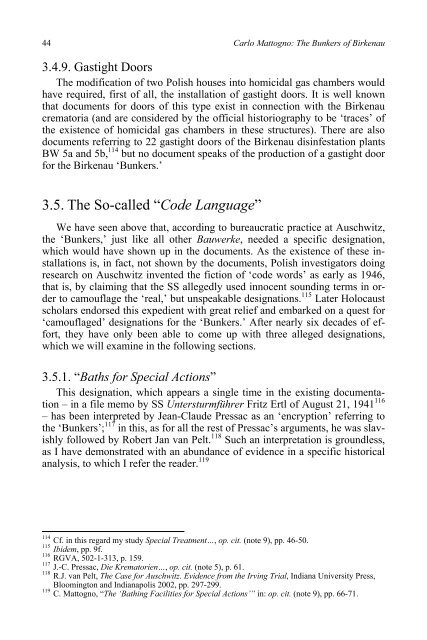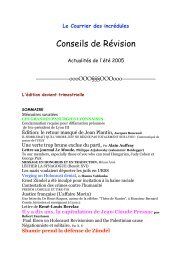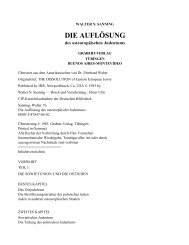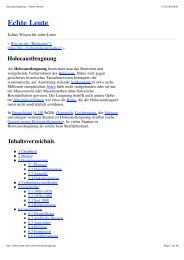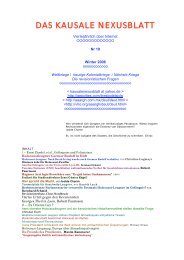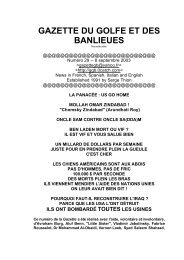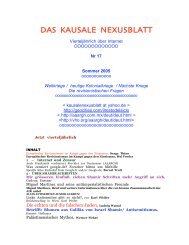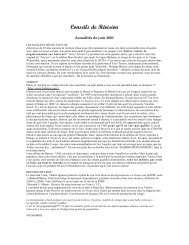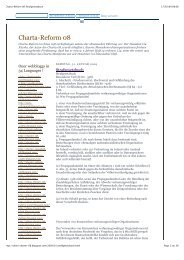Create successful ePaper yourself
Turn your PDF publications into a flip-book with our unique Google optimized e-Paper software.
44 Carlo Mattogno: <strong>The</strong> <strong>Bunkers</strong> of Birkenau<br />
3.4.9. Gastight Doors<br />
<strong>The</strong> modification of two Polish houses into homicidal gas chambers would<br />
have required, first of all, the installation of gastight doors. It is well known<br />
that documents for doors of this type exist in connection with the Birkenau<br />
crematoria (and are considered by the official historiography to be ‘traces’ of<br />
the existence of homicidal gas chambers in these structures). <strong>The</strong>re are also<br />
documents referring to 22 gastight doors of the Birkenau disinfestation plants<br />
BW 5a and 5b, 114 but no document speaks of the production of a gastight door<br />
for the Birkenau ‘<strong>Bunkers</strong>.’<br />
3.5. <strong>The</strong> So-called “Code Language”<br />
We have seen above that, according to bureaucratic practice at <strong>Auschwitz</strong>,<br />
the ‘<strong>Bunkers</strong>,’ just like all other Bauwerke, needed a specific designation,<br />
which would have shown up in the documents. As the existence of these installations<br />
is, in fact, not shown by the documents, Polish investigators doing<br />
research on <strong>Auschwitz</strong> invented the fiction of ‘code words’ as early as 1946,<br />
that is, by claiming that the SS allegedly used innocent sounding terms in order<br />
to camouflage the ‘real,’ but unspeakable designations. 115 Later Holocaust<br />
scholars endorsed this expedient with great relief and embarked on a quest for<br />
‘camouflaged’ designations for the ‘<strong>Bunkers</strong>.’ After nearly six decades of effort,<br />
they have only been able to come up with three alleged designations,<br />
which we will examine in the following sections.<br />
3.5.1. “Baths for Special Actions”<br />
This designation, which appears a single time in the existing documentation<br />
– in a file memo by SS Untersturmführer Fritz Ertl of August 21, 1941 116<br />
– has been interpreted by Jean-Claude Pressac as an ‘encryption’ referring to<br />
the ‘<strong>Bunkers</strong>’; 117 in this, as for all the rest of Pressac’s arguments, he was slavishly<br />
followed by Robert Jan van Pelt. 118 Such an interpretation is groundless,<br />
as I have demonstrated with an abundance of evidence in a specific historical<br />
analysis, to which I refer the reader. 119<br />
114<br />
Cf. in this regard my study Special Treatment…, op. cit. (note 9), pp. 46-50.<br />
115<br />
Ibidem, pp. 9f.<br />
116<br />
RGVA, 502-1-313, p. 159.<br />
117<br />
J.-C. Pressac, Die Krematorien…, op. cit. (note 5), p. 61.<br />
118<br />
R.J. van Pelt, <strong>The</strong> Case for <strong>Auschwitz</strong>. Evidence from the Irving Trial, Indiana University Press,<br />
Bloomington and Indianapolis 2002, pp. 297-299.<br />
119<br />
C. Mattogno, “<strong>The</strong> ‘Bathing Facilities for Special Actions’” in: op. cit. (note 9), pp. 66-71.


